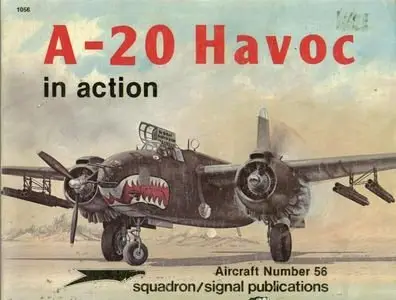Jim Mesko - A-20 Havoc in action - Aircraft No. 56
Squadron/Signal Publications | 1983 | ISBN: 0897471318 | English | 51 pages | PDF | 7.65 MB
Squadron/Signal Publications 1056
Squadron/Signal Publications | 1983 | ISBN: 0897471318 | English | 51 pages | PDF | 7.65 MB
Squadron/Signal Publications 1056
In the mid-1930's. numerous international incidents flared up Throughout the world which would eventually engulf the world in the most devastating war in its history. In the far East, Japan took Manchuria from the Chinese and then used it as a base tor further aggression against them in 1937. Italy used a trumped up border incident in Ethiopia as an excuse for invading the tiny African nation in 1935. Adolf Hitler, in open defiance of the Versailles Treaty, created the Luftwaffe in March. 1935. and reoccupied the demilitarized zone of the Rhineland a year later. During the summer Of 1936. the Spanish Civil War broke Out. This was to serve as a dress rehearsal for World War Two. Germany and Italy supporting the Nationalist rebels while Russia gave aid to the Loyalist government. All three countries tested their latest weapons and sent troops and aircrews to gain combat experience.
Though most individuals m the United States chose to ignore the gathering war clouds, a 'ew were farsighted enough to begin laying plans for the possibility of U.S. involvement. Fortunately, this included the design staff of the Douglas Aircraft Company. In appraising the future needs of u S Army Air Corps attack aircraft. Douglas realized that the current concept of single engined attack aircraft, epitomized by the Northrop A-17. would never be sufficient far a modern war. Rathe', the staff felt that a new class of light, twin-engined planes would have to be developed. In a rather unique move, Douglas decided to begin the basic design of such an aircraft even before the army requested such an aircraft.
The design team, made up of Jack Northrop and Ed Heinemann, began in March 1936 to work on the basic design. This initial version, designated Model 7A. was to gross 9,500 pounds, fly at 250 miles an hour, and have a crew of three. By December 1936, the design was over fifty percent complete but new information coming out of the Spanish Civil War caused Douglas to hold up further work. By the fall of 1937, the army had formalized their requirements and issued a design competition based on intelligence material from Spain. These specifications included a 1200 mile range, a speed of over 200 miles an hour and a bomb load of 1200 pounds.



